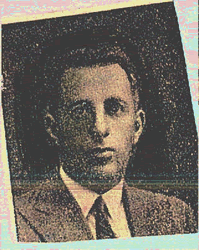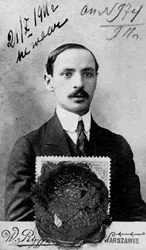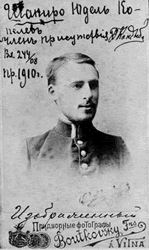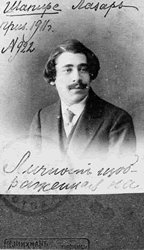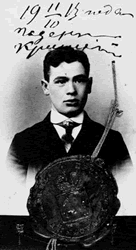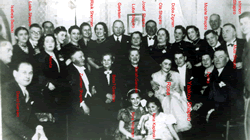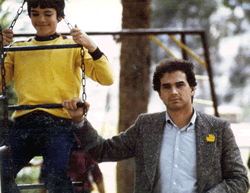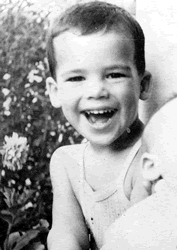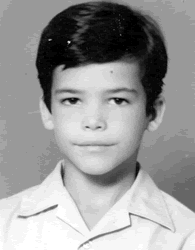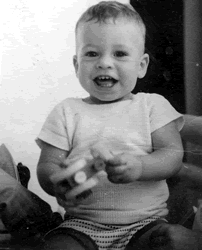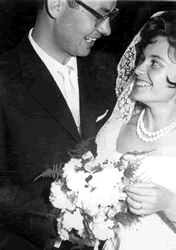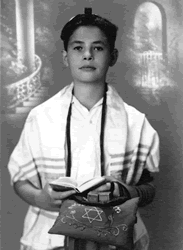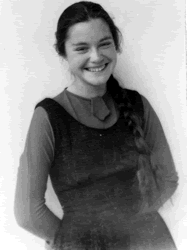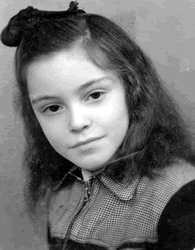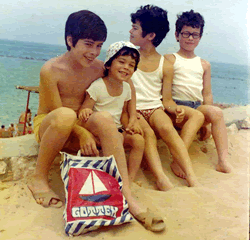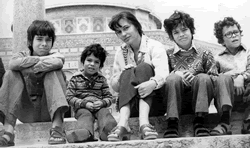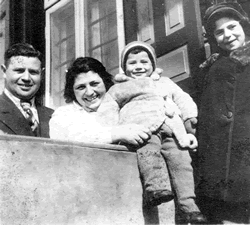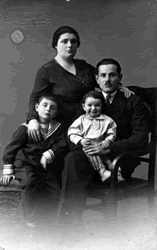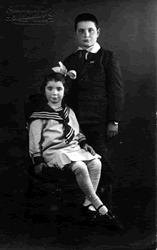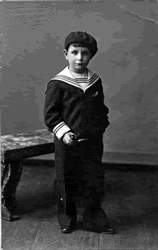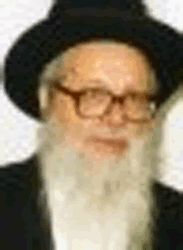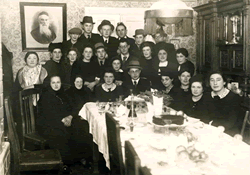Previous Ashkenazi Chief Rabbi of the State of Israel
Chief Rabbi Abraham Shapira, Rosh Yeshivat Mercaz Rav, is one of the most prominent and outstanding Torah scholars of our generation.
He combines the singular ability of a rosh yeshiva with the authority of a scholar who is frequently consulted on the most difficult issues the Jewish world is confronted with today: questions of status - especially among the new immigrants - marriage and divorce, kashrut and Eretz Israel.
Rabbi Shapira served in Rabbinical Courts for more than 40 years. He was head of the Rabbinical Court in Jerusalem, a member of the Supreme Rabbinical Court and finally its president.
In 1983 he was appointed Chief Rabbi of the State of Israel. He held this high office until 1993.
Rabbi Shapira is wellknown to all his students as one whose heart is always open to them.
#spr-7:
The wedding of Rosa and Yaakov Shapiro ( They both perished in Vilna in 1944)
Pictures given by their grandson; Gady Margalit in Israel
#spr-19
The Shapiro family in prewar Vilna.
Ita Shapiro (later Ein Dor) is the daughter of Yehuda Shapiro b. 1901 (Vilna) and Miriam Rabinowicz 1896 (Vilna). Ita's brother Chaim was born in 1925, and she was born in 1
#spr-20
Ita and Chaim Shapiro
#spr-21
Chaim Shapiro, he perished in the holocaust
#spr-22:
Rav Refael
Shapiro Shapira
Birth: 1920 - Russia
Death: Dec 8 1997 - Israel
Parents:
Israel Isser Shapiro and Toybe Zelda Chana Shapiro (born Mankevitz)
#spr-23:
My grandparents are the couple seated in the middle. We have a cousin who is still alive and she is in this picture. She is the one who confirmed that the photo was taken in the Rav’s house (Shapiro Kahana), which my father thought he remembered his mother mentioning but wasn’t sure. This cousin also mentioned that some of the Rav’s sons are in this picture as well. Do you know perhaps which sons would still have been in Kovno in December of 1939, when this picture was taken?
. My grandmother’s family goes back many generations therein Kaunas (Markus and Shapiro families but no relation to the Rav as far as I know). My great grandfather, Yechezkel Gershon, was a wagon driver who would drive all the rabbanim and roshei yeshiva around. He was called “Chatskel the Langer.” In fact, my uncle just told us a story. My great aunt was living in Boston before the war and the Rav came to the US to fundraise. She went to the event, even though no women were allowed in. She told the man at the door to tell the Rav that Chatskel the Langer’s daughter was here and the Rav came outside to greet her!
Tova Levi
#spr-24:
born in
Kobrin in 1871 and was both the grandson and the great-grandson of the
rabbi Chaim of Volozhin. He studied in the Volozhin Yeshiva and in
1913 he became the head rabbi of Kovno.
He died in 1943 in the Kovno ghetto. His father;Rav Zalman Sender
Kahana-Shapira, born in Nisowiz, in the Minsk region, to Rav
Moshe Shapira Kamenetzky, av beis din of Lida and son-in-law of Rav
Chaim of
Volozhin. Rav Zalman sender learned under the Beis HaLevi and his son,
Rav Chaim Brisker, in Volozhin. He married and lived in Kobrin, where
he raised 5 children (4 boys and a girl). When his wife tragically
passed away, he married the widow of Rav Binyamin Wolf Hayahalomstein,
Rav of Maltsch, and moved to that city. He eventually became Rav of
Maltsch and started a yeshiva there, Anaf Eitz Chaim, modeling it
after Eitz Chaim of Volozhin. In 1902, he moved the yeshiva to Kriniki
where he became Rav. Among his students there were Rav Yaakov
Kamenetzky and Rav Aharon Kotler. In 1921 he moved to the Shaarei
Chesed section of Yerushalayaim. (1851-1923) in the Yeshiva of the
city of Krynki that was under the direction and supervision of the
Gaon Rabbi Shlomo Zalman Sender Kahana Shapira of holy blessed memory,
who served as the rabbi of Krynki for many years.
Rabbi Zalmen Sender Kahane Shapiro and his yeshiva
Rabbi Zalmen Sender, son of Rabbi Yakov Kahane Shapiro, rabbi of
Krinki between 1903-and 1915, was the great grandson of Rabbi Chaim
Volozhiner and came from Niesvizh. He was a child prodigy and later
acquired the reputation of a prominent man, a sagacious scholar well
versed in the Talmud. In 1885 he was appointed rabbi of Maltsh and he
founded and was head of a yeshiva there, which became one of the best
and most respected yeshivas in Lithuania. His educational method was
based on inspiring the students to grasp each Talmudic topic according
to its content and root. Among the rabbis who studied in the yeshiva
of Maltsh, Rabbi Yisroel Iser Unterman, chief rabbi of Palestine, must
be remembered.
After the death of Rabbi Baruch Lavski, the Jewish community of Krinki
offered the rabbinical chair to Rabbi Zalmen Sender and he accepted
the office on condition that he could continue to devote himself to
his yeshiva, a part of which was to come over to Krinki. Established
in Krinki, the yeshiva, called 'Anaf Etz ha-Chaim', with Rabbi Zalmen
Sender as its head, kept its reputation as one of the most outstanding
yeshivas and it attracted as many as 80 students from near and far.
As the rabbi of the town Rabbi Zalmen Sender was widely accepted,
respected and liked by the Krinki public. However, "he did not find
favor in the eyes of the Krinki manufacturers because he associated
too closely with the workers", tells us A. B. Miller. Once his
attention was called to this and he was asked: "Is it not written:
Rabbi, honor the rich?" Rabbi Zalmen Sender answered at once, "The
rabbi knew who was rich but I don't know…". Rabbi Zalmen Sender, as
Yosl Kohn and B.Patchebutzki tell us, would often stand up for the
craftsmen and reprimand the manufacturers. He even refused to pray in
the bes-medresh of the wealthy and preferred to pray in the
'Caucasian' prayer house together with the common people and the
toilers.
As an accepted authority, Rabbi Zalmen Sender used to influence the
sick and the weak and even order them to eat on Yom Kippur. He would
even send a doctor to examine the sick and if it turned out that a
person would not be able to survive a fast day, Rabbi Zalmen Sender
would go himself to him and force him to eat, even before his very
eyes. In 1915 when the front was approaching Krinki Rabbi Zalmen
Sender moved to Tule (Central Russia) with a group of his students and
after the war he made aliya and settled in Jerusalem where he spent
his last years and died in 1923.
His son, Rabbi Avrom Dober Kahane Shapiro, was the last chief rabbi of
Lithuania and rabbi of Kovno and he is the author of the well-known
classic book entitled Shaale u-Tshuve Devar Abraham [Devar Abraham
(Rabbinical Responsa)]. He died in the Kovno ghetto in 5703 (1943).
Rabbi Zalmen Sender's second son, Rabbi Chaim, was at first rabbi in
Koznitze and later in Slobodke, a suburb of Grodno.
One of Rabbi Zalmen Sender's grandsons – Rabbi Avrom Dober's sons who
were raised in Krinki – Chaim Nachum Shapiro was professor of Hebrew
and oriental languages at the University of Kovno. He was a prominent
scholar of new Hebrew literature and author of two books, among others
– one on new Hebrew literature and the other on Haskalah literature in
Central Russia – which were published in Palestine. He perished with
the entire Kovno Jewish community. Rabbi Zalmen Sender's other
grandson, Dr Noach Shapiro, was associate professor of chemistry at
the University of Kovno and he made aliya in 1935 and became professor
of chemistry at the Bar-Ilan University. He died in 1964. Father of
Emmanuel Shapira M.D and Ph.D. Genetics (born in Kovno in 1933- died
in New Orleans in 1998) ? Performances were given in the ghetto's
Police House, the former building of the Slobodka Yeshiva. They were
coordinated by the ghetto's director of education and culture, the
noted linguist Chaim Nachman Shapiro (who was also the son of Kovno's
chief rabbi)The Department of Semithology at the University of Kaunas
(since 1930 Vytautas the Great University began its work at the
beginning of 1926 when its Head became Dr. Nachman Shapira, a son of
A. D. K. Shapira, the Chief rabbi of Kaunas and Lithuania. The
Department trained teachers for Jewish schools. In 1932 the decree of
the President of Lithuania conferred to Dr. N. Shapira a degree of the
Associate professor. N. Shapira was a prominent scholar. He wrote a
lot of scientific articles, several monographs. His "Modern Hebrew
Literature" (I part) was simultaneously published in Kaunas and Tel
Aviv (in 1940). The second edition was published in already
independent Israel in 1967. November 25
The Education Office is established under direction of cultural leader
Chaim Nachman Shapiro. Shapiro also launches a secret archival project
and encourages artists and writers to begin documentary efforts.
linguist Chaim Nachman Shapiro and his family weree killed at Fort IX
after being led to believe they were to have safe passage to
Switzerland. 1943 December 2
Due to the death of the author in Kaunas ghetto in 1943 the book
remained unfinished.
Shapiro Khaim Nachman
Khaim Nachman Shapiro was born in Russia in 1900 to Avraham Dov and
Rakhel. He was a university professor and married and had a child
Itamar. Prior to WWII he lived in Kowno, Lithuania. Khaim perished in
1942 in Kowno. This information is based on a Page of Testimony
Shapiro Rakhel
Rakhel Shapiro nee Perlman was born in Russia. She was a rabbi's wife
and married. Prior to WWII she lived in Kowno, Lithuania. During the
war was in Kowno, Lithuania. Rakhel perished in 1942 in Kowno. This
information is based on a Page of Testimony (displayed on left)
submitted on 19/04/1955 by her daughter-in-law; Mina Shapira of Tel
Aviv
Mirla Bornstein
Mirla Bornstein nee Kahana Shapira was born in Miechow, Poland in 1885
to Av beit din, Rav Moshe Natan Kahana Shapira and Golda. She was a
rabbi's wife and a widow of Rabbi Szmuel. Prior to WWII she lived in
Zgierz, Poland. During the war was in Warszawa, Poland. she perished
in 1943 in Treblinka at the age of 58. This information is based on a
Page of Testimony (displayed on left) submitted on 18/04/1999 by her
son Aron Israel, a Shoah survivor who lives in Natania
After the war, the Shapiro family returned to Bialystok where Moshe Shmuel studied in the local Yeshiva. Rabbi Chaim Brisker, Moshe Shmuel's uncle, frequented the Shapiro residence. In 1933, Moshe Shmuel left home to study in the Yeshiva in Baranovich under the tutelage of Rabbi Elchonon Wasserman. Rabbi Shmuel Berenbaum, the Rosh Yeshiva of Yeshivas Mir attests to the special relationship which existed between Moshe Shmuel and Rabbi Wasserman. Even after Moshe Shmuel left Baranovichi , he continued corresponding with Rabbi Wasserman.
In the summer of 1936 Moshe Shmuel moved to Yeshivas Mir were he immediately gained a reputation as having potential for leading the Torah world and was recognized by Rabbi Yerucham Levovitz. Moshe Shmuel joined students older than himself in sleeping arrrangements, despite his young age compared to them. He developed a friendship with such Torah scholars as Rabbbi Yonah Karpilov of Minsk (who was murdered in the Holocaust) and Rabbi Aryeh Leib Malin. In 1937, after reaching the age of army conscription, Moshe Shmuel had to flee Poland and moved to Palestine.
In Palestine, Moshe Shmuel attended Yeshivas Lomzha in Petah Tikva, where Rabbi Yechezkel Levenstein recognized his potential. During this time in Lomzha, Rabbi Elazar Shach was the main Talmudic lecturer, while Rabbi Moshe Shmuel and Rabbi Shmuel Rozovsky delivered other specialized lectures in the Talmud studies. During this time, Rabbi Moshe Shmuel was the teacher of many Rabbis including Rabbi Chaim Kanievsky.
When Rabbi Moshe Shmuel's first cousin, the Brisker Rov moved to Jerusalem , Rabbi Moshe Shmuel developed a strong relationship with him and helped publicize the Brisker methods. He was given special access to writings from his cousin and his uncle, Reb Chaim Brisker, which he incorporated into his own understandings of various Gemara sugyas. Rabbi Moshe Shmuel was the main editor of the works of the Brisker Rov on Kodoshim.
Reb Moshe Shmuel was granted semicha by Rabbi Isser Zalman Meltzer .
During this period he also became very close to the Chazon Ish. After his marriage in 1946, Rabbi Moshe Shmuel spent one year learning the Chazon Ish's Kollel and then was hired to deliver Talmudic lectures in Yeshivas Kol Torah for three years. At the behest of the Chazon Ish, Rabbi Moshe Shmuel joined Rabbi Shlomo Wolbe in establishing Yeshivas Be'er Yaakov. He was also the Chief Rabbi of Ramle, the town where his Yeshiva was located, for a short time before resigning because it took away too much time from running his Yeshiva.
Rabbi Moshe Shmuel consulted with the Chazon Ish and Brisker Rov on all the Yeshiva's matters. In 1954, on the day of the death of the Chazon Ish, Rabbi Moshe Shmuel held a two hour conversation in Torah with the aging sage.
In 1968, Rabbi Moshe Shmuel was repeatedly asked to join the Moetzes Gedolei HaTorah by Rabbi Yisrael Alter, the Gerrer Rebbe and Rabbi Yechezkel Sarna. Eventually he acceded to their request when the latter paid him a personal visit.
Works
From the year 1963 until the year of his death, Rabbi Moshe Shmuel published many Talmudic works on the Orders of Nashim, Nezikin, and Moed. They are broken up into two sets of books: Kuntres HaBiurim are in-depth analysis of various Talmudic topics, oftentimes based on exclusive manuscripts and ideas which Rabbi Moshe Shmuel heard from the Brisker Rov. Sha'arei Shemoous is a compilation of Rabbi Moshe Shmuel's novellea arranged per folio in the Talmud on the tractates which he published his works. The sons of Rabbi Moshe Shmuel also published posthumously his work on Tanach entitled Zahav MiShvah. He also worked extensively with manuscripts of various Rishonim and published a special edition of the Ri Migash with his own footnotes.
From Wikipedia, the free encyclopedia
Here is the history of my ancestors that I have researched carefully over the past 2 years.
Rabbi Aryeh Leib ben Yitzchak Spira was born in L'vov in 1701. His father, Yitzhak ben Eliezer (born in 1650) wrote Elef Ha-Magen printed by his son Nathan Spira- Zolkiev, 1732), died (March 16, 1711) in L’viv when Aryeh Leib was was 9 or 10 years old; his mother Nehama raised him and encouraged his learning. In his childhood, he was taken to Vilna to be educated due to his precocity. Nehama died before he married. He married the daughter of Mordecai ben Azriel. He was supported by his father-in-law, a well-to-do merchant and prominent citizen. Aryeh Leib became a rabbinic judge and scribe of Vilna. He wrote "Na?alat Ariel" and "Me'on 'Arayot" (Dyhernfurth, 1732), a double commentary on the treatise Soferim when he was 21 years old. He wrote a book on Hebrew grammar called Kebuzat Kesef (published by Zolkiev in 1741). Rabbi Aryeh Leib Spira died in April, 1761 in Vilna. The son of R. Aryeh Leib Spira was R. Eliezer Shapira. Aryeh Leib’s daughter married the scholar, R. Moshe Heilprin.
R' Eliezer was born in about 1730. It was at the time when this family was beginning to be called Shapira rather than Spira. Not much is known about him although he was known as a ‘Gaon rabbi;’ and well known in Lithuania. He served as the head of the rabbinical court in Lubtch (Lyubcha) but the exact dates are unknown. He was married to the daughter of a Rabbi Schick, and had two daughters. One was married to Rabbi Chaim Epshtein of Vilna and the other, named Gitel Shapira, born between 1760 and 1770, was married to R. Yitzhak Menachem Zundel Shapira of Ivanitz (a different Shapiro lineage).
R. (Yitzchak) Menachem Zundel Shapira was born in Ivanitz, the son of R. Yitzhak Shlomo Shapira in about 1763. His first wife died, and he then married Gitel Shapira of Vilna in Lubtch. It is not known if these two families, both named Shapira, were closely related. Menachem Zundel became ABD of Ivanetz.
Menachem Zundel and Gitel had one son together, the Gaon Rabbi Aryeh Leib Shapira, born in 1789 in Ivanetz. At the age of 32, when his son was 6 years old, R. Menachem Zundel died. Gitel then raised Aryeh Leib in the house of her father Rabbi Eliezer of Lubtch. Apparently, she died young as well, although details are not known. Rabbi Aryeh Leib studied Torah in the local study hall in Lubtch with his relative, Shmuel Bakshter, who was five years his senior, and together they went to study at the yeshiva in Volozhin, one of the first which was founded by the Gaon R' Chaim, a disciple of the Vilna Gaon. Rabbi Aryeh Leib was one of the first students of the newly established Volozhin Yeshiva (in 1803) and one of the greatest disciples of Rabbi Chaim (1749-1821) who ordained him. In 1815 when he was 30 he became the rabbi of Volozhin and Vasilishok.
In 1817 Rabbi Aryeh Leib became rabbi in Il’ya where he was ABD. From there he moved to Kalvaria in 1823 and then Rabbi Menashe appointed him rabbi in Smorgon from 1828-1839. He came to Kovno in either 1839 or 1848 where he become the first rabbi in Kovna to have the title of Rosh Beit Din and was known as the Gaon Rabbi 'Leibele.' During his time at Kovno he became well known as the opponent of the Gaon Rabbi Yisrael Salanter (1809-1883) and his Beit Hamusar (House of Moral Teachings).
Rabbi Aryeh Leib's first marriage was in Il’ya where he married Zivia Rachel Bunimowitz (Bunamovich), probably the daughter of R. Yitzhak or Aharon Bunimowitz. He had two children with her, Yitzchak Menachem Zundel in 1809 and Chaim Avraham in 1821. Presumably she died. He then married Esther Lejowitch who was the granddaughter of Gaon Aryeh Leib Shick, ABD of Vasilishok, in Kalvaria, and they had eight children, R. Raphael in 1837 in Smorgon (ABD and Rosh Yeshiva Volozhin), R. Levi in 1841 (Rabbi of Trisk; ABD Novo Alexandrowsk (Zarasai), R. Moshe Shmuel in 1843 (Rabbi of Brisk, ABD Ramygala, Korsun, Bobruisk), Chaim Zvi, Sarah (married to R’Moses Solomon Ginsberg, ABD Ilya), Miriam (married to R. Gershon Zafran of Kalvarija), and R. Schlomo (changed his name to Rabinowitz…ABD Pienai). R. Raphael was known as the Gaon Rabbi of Volozhin, serving as the head of the yeshiva. Rabbi Aryeh Leib lived his later years in Kalvariya and died there on 27 Jan 1853. Elsa
